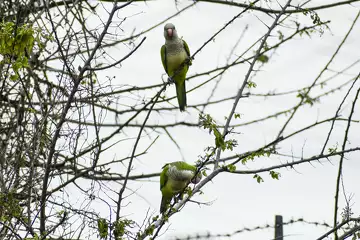Wild parrots poised for world domination settle for Houston first
Monk parakeets weren't born in Texas, but they got here as fast as they could.
By Ariana GarciaApril 21, 2024
Monk parakeets are seen on a tree near electrical lines in Pearland, Texas.
Ariana Garcia

Among gatherings of grackles, doves, and other feathered friends commonly found throughout the state of Texas stands out a lime green species that is not actually from around these parts. Popularly known as the monk parakeet or quaker parrot, bands of the wild, gray-faced parrots have slowly carved out a home for themselves in the Lone Star State, trading in the grasslands of their native Argentina for sprawling utility structures, like cell phone towers and electrical substations. Even though they've been in the States for a while, some still have questions.

In the Greater Houston Area, colonies of the dove-sized species—named for their monk-like hooded appearance—have recently been spotted in Bellaire, Deer Park, and Sugar Land. In Pearland, flashes of the chunky birds' quick-beating green wings through the trees have become anything but a rarity. In the suburb south of Houston, their territory of choice is CenterPoint Energy structures, though they also take advantage of exotic ornamental plants popular in local landscaping. The energy company said monk parakeets are known to nest on its power delivery equipment, which can sometimes cause outages.
Monk parakeets like to nest on power delivery equipment, which can present some concerns for power outages. Ariana Garcia
"In some cases, monk parakeet nests present operational concerns, and we carefully remove them," Logan Anderson of CenterPoint told Chron. "As part of our comprehensive avian protection program, we manage bird nests in a humane manner, under proper authorizations, and in collaboration with natural resource agencies and wildlife rehabilitation professionals."
Cullen Ondracek, Pearland natural resources manager, said the first reported sighting in the community was in 2011. Even though the exotic species are not the most exciting for avid bird watchers to find, they still take some residents by surprise, Ondracek said. The Natural Resources Division of the Houston Parks and Recreation Department counted 68 of the birds when it first started taking count of local species in 2015. "Of course, they were in the Houston area several years before that, and just because that was the first reported record doesn't mean they were not here before that," he told Chron. "I see them flying on the east side of Pearland fairly commonly, which makes sense as they will be more concentrated near their nesting/roosting site."
The City of Houston first started taking count of monk parakeets in the area in 2015, counting 68 individuals that year.

Ariana Garcia
Arguably, their most well-known colony in the suburb exists at a CenterPoint Energy station off Broadway near the Pearland Parkway intersection. Marlene Smith of St. Andrew's Episcopal Church next door told Chron a breeding pair first appeared outside the chapel in 2005, seemingly blown in from parts unknown during Hurricane Rita. Since then, the monk parakeet outpost has only continued to grow in numbers.
Smith said they spend their time gathering in the trees in the afternoon, often becoming quite vocal, making a distinctive call as they fly past. "They camouflage themselves nicely against the trees, and often we can't see them, but we know they are there," she said. From time to time, visitors come to take photos and ask about the birds. "We've had some people come to the door thinking that someone's bird has gotten loose," Smith said. "I think everyone here loves them, and we have sort of adopted them as our own."
Exotic monk parakeets have reportedly called Texas home since the 1960s.Ariana Garcia
Wild populations of the vibrant species first appeared in the U.S. in the 1960s, likely introduced as a result of the pet trade. Per Texas State University, monk parrots escaped accidentally and were released in various parts of the country. Their high tolerance for a wide range of temperatures has helped them to become established. Today, populations of the birds exist as far north as New York and Chicago, and in the southeasternmost part of the U.S. in Florida. In Texas, the species is also locally common in Austin, San Antonio, Galveston, Corpus Christi, Weslaco, and El Paso.
Because they are an introduced exotic species and non-migratory, they can be seen year-round locally, explained Wyatt Egelhoff, a conservation specialist with the Houston Audubon. "They are locally common in urban/suburban areas in the more populated cities in Texas, but are seldom seen away from these areas," he told Chron, noting that this means they are also not technically an invasive species. "Their behavior of building large communal nests makes them more resilient to cold weather than other parakeets, which is why they've been able to establish themselves."
 
Monk parakeets can be spotted on power lines throughout Houston.

Ariana Garcia
Other than their perceived threat to power infrastructure, Egelhoff said monk parakeets could also potentially act as vectors for diseases that could impact native green parakeets. "I do not know that this has ever been documented and the monk parakeet population in those areas is small enough that it seems unlikely," he added.
Since the Texas Parks and Wildlife Department (TPWD) focuses on native species, there isn't an estimate on how many monk parakeets reside in the state. However, the state agency encourages Texans to record observations of the birds on iNaturalist.org. An interactive map on the resource depicts recent sightings in Amarillo and Laredo, indicating that electric green birds are expanding their reach. It's unclear just how monk parakeets made it to Texas, thousands of miles away from South America. However, one thing is certain: They are here to stay. |










